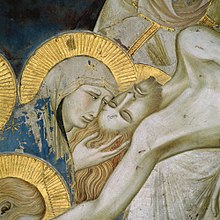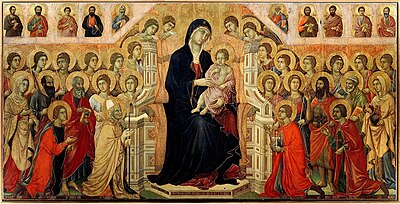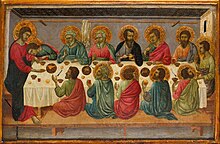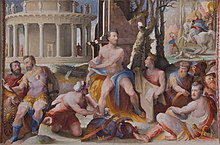|
Sienese school The Sienese school of painting flourished in Siena, Italy, between the 13th and 15th centuries. Its most important artists include Duccio, whose work shows Byzantine influence, his pupil Simone Martini, the brothers Pietro and Ambrogio Lorenzetti and Domenico and Taddeo di Bartolo, Sassetta, and Matteo di Giovanni. History Duccio may be considered the "father of Sienese painting".[1] The brothers Pietro and Ambrogio Lorenzetti were "responsible for a crucial development in Sienese art, moving from the tradition inherited from Duccio towards a Gothic style, incorporating the innovations in Florence introduced by Giotto and Arnolfo di Cambio".[2] "Sienese art flourished even when Siena itself had begun to decline economically and politically. And while the artists of 15th-century Siena did not enjoy the widespread patronage and respect that their 14th-century ancestors had received, the paintings and illuminated manuscripts they produced form one of the undervalued treasures in the bounty of Italian art."[3] In the late 15th century, Siena "finally succumbed" to the Florentine school's teachings on perspective and naturalistic representation, absorbing its "humanist culture".[3] In the 16th century the Mannerists Beccafumi and Il Sodoma worked there. While Baldassare Peruzzi was born and trained in Siena, his major works and style reflect his long career in Rome. The economic and political decline of Siena by the 16th century, and its eventual subjugation by Florence, largely checked the development of Sienese painting, although it also meant that a good proportion of Sienese works in churches and public buildings were not discarded or destroyed. StyleUnlike Florentine art, Sienese art opted for a more decorative style and rich colors, with "thinner, elegant, and courtly figures".[4] It also has "a mystical streak...characterized by a common focus on miraculous events, with less attention to proportions, distortions of time and place, and often dreamlike coloration".[3] Sienese painters did not paint portraits, allegories, or classical myths.[5]  List of artists1251–13001301–1350
1351–1400
1401–1450
1451–1500
1501–1550
1601–1650See alsoReferences
Further reading
External linksWikimedia Commons has media related to Sienese School of painting.
|